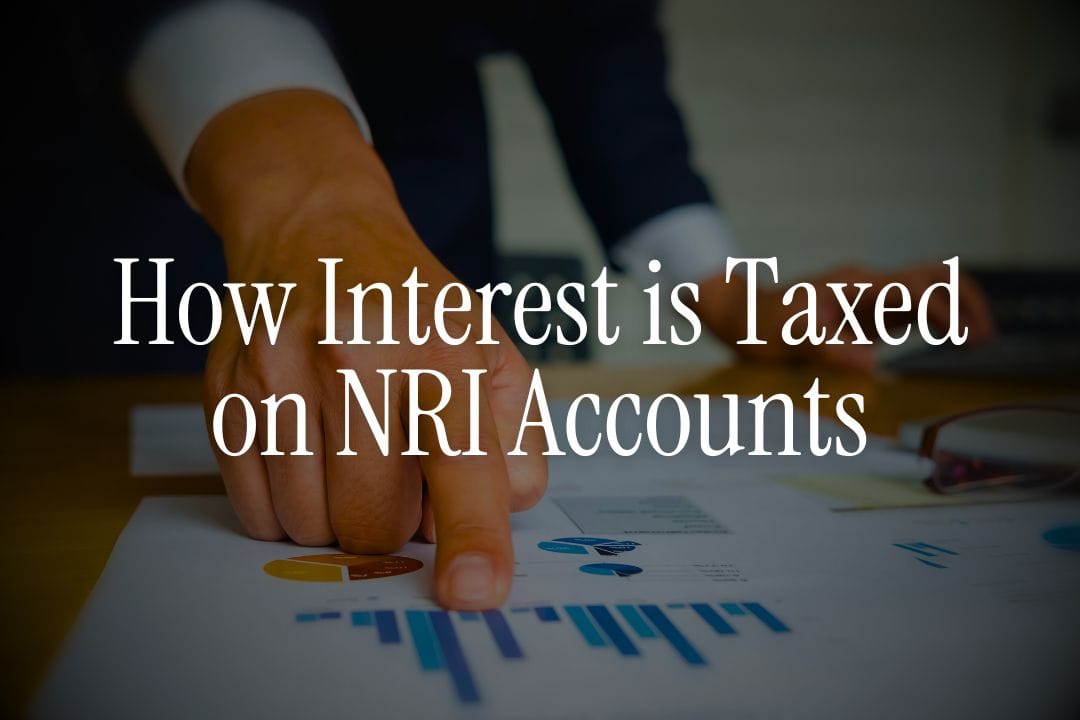
Rajesh from Dubai got a shock last month. His ₹50 lakh NRO fixed deposit earned ₹3.5 lakh interest, but ₹1.05 lakh was deducted as TDS (Tax Deducted at Source).
His WhatsApp group exploded with "advice":
"All NRI accounts are tax-free in India!"
"You can avoid tax by switching banks!"
"DTAA means no tax for UAE residents!"
"Small amounts don't attract TDS!"
Every single statement above is wrong. And believing these myths costs NRIs lakhs of rupees every year.
The truth?
Interest taxation on NRI accounts follows specific rules that most NRIs don't understand.
Some accounts are completely tax-free, others face 30% TDS, and many fall somewhere in between depending on your country of residence.
What the Rules Actually Say
Let me share what really happened to Rajesh and thousands of other UAE NRIs. After proper DTAA planning, his effective tax rate dropped from 30% to 12.5%, saving him over ₹60,000 annually.
Here's the reality: Interest taxation depends entirely on your account type and residential status. Not your bank, not your deposit amount, not your citizenship.
Current Tax Rules (2025):
The Income Tax Act 1961 is crystal clear:
- Interest from NRE and FCNR accounts: Tax-free in India
- Interest from NRO accounts: Taxable at 30% TDS (plus cess and surcharge)
- The India-UAE DTAA reduces the tax on NRO interest to 12.5%. For other countries, rates vary, often between 10-15%.
👉 Key insight: The account type determines taxation, not the bank or your passport.
How It Really Works
NRE Account Interest: Completely Tax-Free
Under Section 10(4)(ii) of the Income Tax Act, interest earned on NRE accounts is exempt from income tax in India.
What this means:
- No TDS deduction on interest payments
- No need to file ITR for NRE interest alone
- Full repatriation allowed without tax complications
Example:
Priya's ₹1 crore NRE FD earns ₹7 lakh annual interest. Tax in India: ₹0
Catch: You can only deposit foreign-source income in NRE accounts. If you're mixing India-source income, you need an NRO account.
FCNR Account Interest: Also Tax-Free
Section 10(15)(iv)(fa) exempts interest on FCNR deposits from Indian taxes.
Benefits:
- Zero currency conversion risk (deposit and withdraw in USD/EUR/GBP)
- Tax-free interest earnings in India
- Complete repatriation freedom
Example:
Ahmed's $100,000 FCNR deposit earns $3,000 annually. Indian tax: $0
Trade-off: FCNR rates are typically 1-2% lower than NRE FD rates.
NRO Account Interest: Heavily Taxed
This is where most confusion happens. All interest from NRO accounts is taxable at 30% TDS under Section 195.
The math:
₹3 lakh interest = ₹90,000 TDS deduction
Your bank credits only ₹2.1 lakh to your account
Why NRO accounts exist:
For India-source income like rent, dividends, business profits, or pension. You cannot deposit these in NRE accounts.
👉 Tip: If you have both foreign income and India income, maintain both NRE and NRO accounts to optimize taxes.
Pros for Gulf-Based NRIs
1. DTAA Benefits Are Massive
The India-UAE DTAA reduces NRO interest taxation from 30% to 12.5%.
Real savings:
₹5 lakh NRO interest:
- Without DTAA: ₹1.5 lakh tax
- With DTAA: ₹62,500 tax
- Annual saving: ₹87,500
Documentation needed:
- UAE Tax Residency Certificate
- Form 10F filing
- Proper bank submission process
2. Zero Tax Jurisdiction Advantage
UAE has no personal income tax, so NRE and FCNR interest remains completely tax-free globally.
Planning opportunity:
Structure deposits in NRE/FCNR accounts to minimize overall tax burden.
3. Strategic Account Mix
Smart NRIs use multiple account types:
- NRE accounts: For foreign salary savings
- NRO accounts: For Indian rental income (with DTAA benefits)
- FCNR accounts: For currency hedging
Also Read - NRE vs NRO vs FCNR
Risks and Limitations
1. TDS vs Final Tax Liability
Many NRIs think TDS is the final tax. Wrong.
TDS is advance tax payment. Your actual liability depends on:
- Your total Indian income
- Applicable tax slabs (₹2.5 lakh or ₹4 lakh exemption limits)
- DTAA benefits available
Example:
Sunita's NRO interest: ₹1 lakh
TDS deducted: ₹30,000
Her total Indian income: ₹1 lakh
Actual tax liability: ₹0 (below exemption limit)
Refund due: ₹30,000
2. Residential Status Changes
When you return to India, account conversion rules change everything:
- NRE to resident account: Interest becomes taxable
- FCNR to RFC account: Interest becomes taxable if you're an ordinary resident
- NRO accounts: Must convert to resident accounts
👉 Important: Inform banks within 30 days of status change to avoid compliance issues.
3. Country-Specific Taxation
While India may not tax NRE/FCNR interest, your resident country might:
US residents: Must report all Indian interest income
UK residents: Indian interest is taxable after personal allowances
UAE residents: No additional tax burden
4. Documentation Compliance
Common mistakes that trigger higher taxes:
- Not submitting TRC (Tax Residency Certificate) on time
- Filing Form 10F incorrectly
- Using outdated forms for new financial years
- Not maintaining proper residency proof
Result: Banks deduct full 30% TDS instead of reduced DTAA rates.
Step-by-Step Application Process
Phase 1: Optimize Your Account Structure
Step 1: Audit existing accounts
List all NRE, NRO, and FCNR accounts with current balances and interest rates.
Step 2: Calculate tax impact
Use our NRI taxation calculator to estimate annual tax outflow.
Step 3: Consider GIFT City alternatives
GIFT City USD FDs offer tax-free returns without currency risk.
Phase 2: DTAA Planning (for NRO accounts)
Step 1: Obtain Tax Residency Certificate
Country | Authority | Processing Time | Validity |
|---|---|---|---|
UAE | FTA (EmaraTax portal) | 7-10 days | 1 year |
USA | IRS | 45-90 days | No expiry |
UK | HMRC | 21 days | 1 Year |
Canada | CRA | 30 days | issued for a specific tax year and is not valid indefinitely |
Step 2: File Form 10F
Submit online at incometax.gov.in with your residential and tax details.
Step 3: Submit to banks
Provide TRC and Form 10F to all banks holding NRO accounts before interest payment dates.
Source: UK TRC certificate
Phase 3: Tax Filing and Optimization
Step 1: Determine filing requirement
You must file ITR if Indian income exceeds:
- ₹2.5 lakh (old tax regime)
- ₹4 lakh (new tax regime for 2025-26)
Step 2: Choose correct ITR form
Most NRIs with interest income use ITR-2.
Step 3: Claim refunds
If TDS exceeds actual tax liability, claim refund through ITR filing.
Also Read - How to File Income Tax Return in India as an NRI
Advanced Tax Planning
1. Income Splitting Strategy
Scenario: You have ₹1 crore to invest and expect ₹7 lakh annual returns.
Basic approach: Single NRO account
Tax: ₹2.1 lakh (30% TDS)
Optimized approach:
- ₹60 lakh in NRE FD: ₹4.2 lakh interest (tax-free)
- ₹40 lakh in NRO FD: ₹2.8 lakh interest
Tax with DTAA: ₹35,000 (12.5%)
Annual saving: ₹1.75 lakh
2. GIFT City Advantage
GIFT City investments offer unique benefits:
- USD-denominated returns (avoid currency risk)
- Tax-free interest income
- No TDS complications
- Professional fund management
Comparison:
Investment | Amount | Annual Return | Tax | Net Gain |
|---|---|---|---|---|
NRO FD | ₹50 lakh | ₹3.5 lakh | ₹1.05 lakh | ₹2.45 lakh |
GIFT City USD FD | $60,000 | $3,000 | ₹0 | $3,000 |
3. Timing Strategies
Interest payment timing: Ask banks to credit interest in the financial year when your Indian income is lowest.
Account conversion timing: If returning to India, convert accounts when you qualify for RNOR status to minimize tax impact.
Your Action Plan
Immediate steps (next 30 days):
Audit your current structure
Calculate annual tax outflow from all NRI accountsApply for DTAA benefits
Get TRC and file Form 10F for your residence countryConsider account optimization
Move foreign-source funds to NRE/FCNR accountsExplore GIFT City options
Compare returns with traditional NRI FDs
Medium-term planning (3-6 months):
Review and rebalance
Optimize the mix of account types based on income sourcesSet up systematic approach
Create annual calendar for TRC renewal and Form 10F filingPlan for status changes
Prepare documentation for potential return to India
Long-term strategy (annual review):
Track tax law changes
Stay updated on DTAA modifications and new opportunitiesEvaluate new products
Consider alternative investments and mutual fund optionsProfessional consultation
Annual review with tax advisor familiar with NRI taxation
Ready to optimize your NRI account taxation? The difference between paying 30% and 0% tax can mean lakhs of rupees annually.
Join thousands of smart NRIs who've discovered tax-efficient USD investments without the complexity of traditional NRI accounts.
Join our WhatsApp community for personalized guidance on NRI taxation and investment strategies.
Download the Belong app to explore GIFT City investments that eliminate TDS hassles while delivering superior returns.
Sources:




